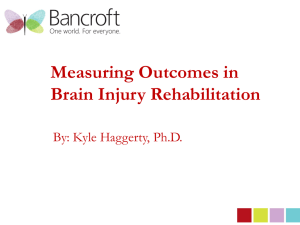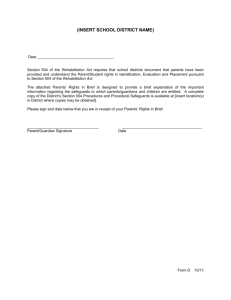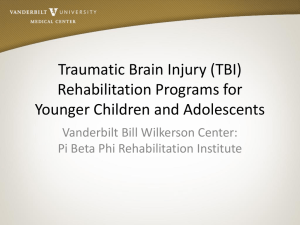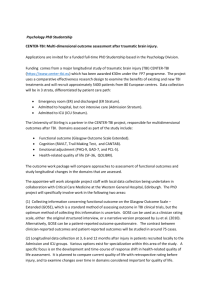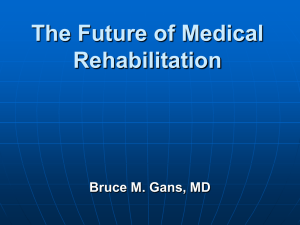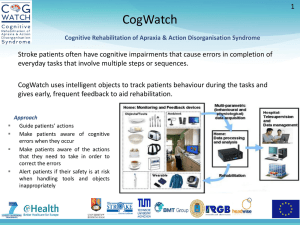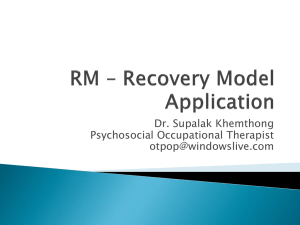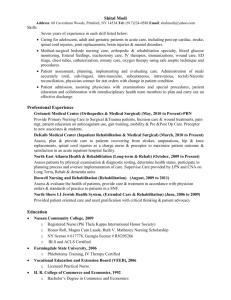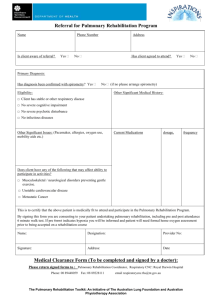Generally, the figures are lower and satisfaction with sexual life was
advertisement
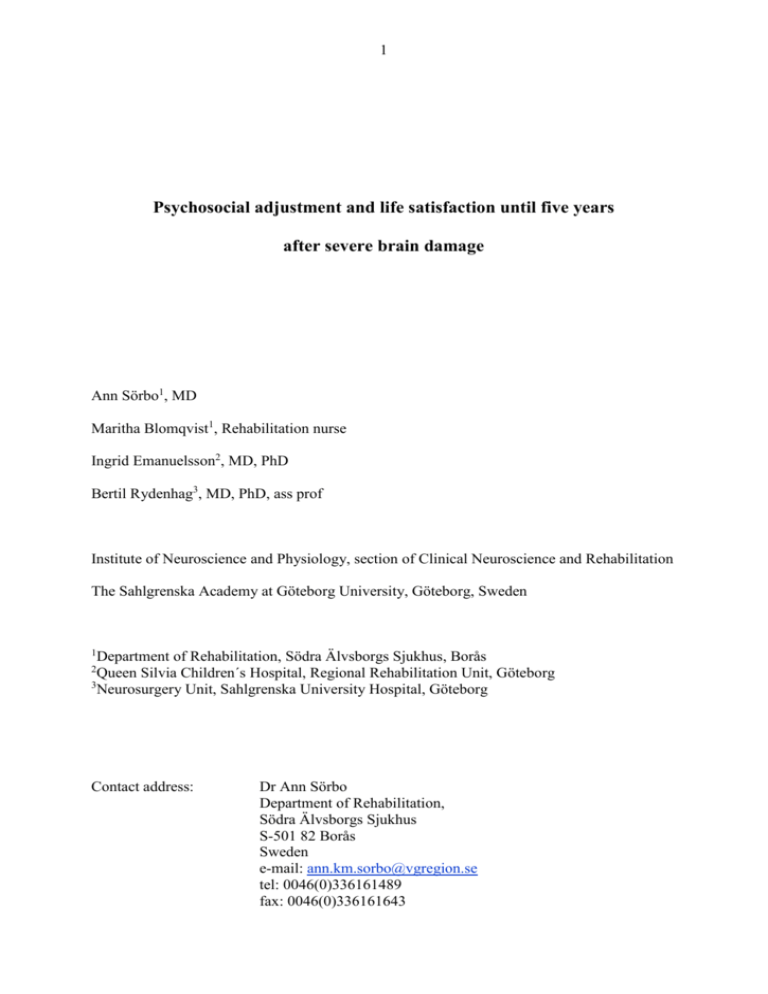
1 Psychosocial adjustment and life satisfaction until five years after severe brain damage Ann Sörbo1, MD Maritha Blomqvist1, Rehabilitation nurse Ingrid Emanuelsson2, MD, PhD Bertil Rydenhag3, MD, PhD, ass prof Institute of Neuroscience and Physiology, section of Clinical Neuroscience and Rehabilitation The Sahlgrenska Academy at Göteborg University, Göteborg, Sweden 1 Department of Rehabilitation, Södra Älvsborgs Sjukhus, Borås Queen Silvia Children´s Hospital, Regional Rehabilitation Unit, Göteborg 3 Neurosurgery Unit, Sahlgrenska University Hospital, Göteborg 2 Contact address: Dr Ann Sörbo Department of Rehabilitation, Södra Älvsborgs Sjukhus S-501 82 Borås Sweden e-mail: ann.km.sorbo@vgregion.se tel: 0046(0)336161489 fax: 0046(0)336161643 2 Psychosocial adjustment and life satisfaction until five years after severe brain damage Ann Sörbo, Maritha Blomqvist, Ingrid Emanuelsson and Bertil Rydenhag INTRODUCTION A well-integrated chain of care for patients with severe brain injuries was established in 1996 at the Neurosurgery Unit at Sahlgrenska University Hospital, Göteborg, and Borås Hospital, Sweden (1). The medical treatment at the Neuro Intensive Care Unit (NICU) and the rehabilitation programme had changed during the previous decade (2-4). For traumatic brain injuries, the so-called “Lund concept” (3, 5) was introduced in Göteborg in the early 1990s. It focused on controlling intracranial pressure, volume regulation and handling the stress response. For subarachnoid haemorrhages (SAH), medical treatment had been further developed with the aim of preventing systemic complications that are attributed to the increased sympathetic nervous activity (6, 7). More patients survive today after severe brain injuries following TBI and SAH with a “good outcome” as classified by the Glasgow Outcome Scale (GOS) (8). In 1994-96, a structured rehabilitation programme for patients with severe brain injuries was developed at Borås Hospital, inspired by the programme at St Francis Hospital, Connecticut, USA (9) and the programme at Therapiezentrum Burgau in Bavaria, Germany (10). The programme at Borås Hospital includes very early and structured rehabilitation interventions performed by a specialised brain injury team. The treatment starts at the intensive care unit or at the emergency wards if the patient cannot be referred directly from the NICU to the rehabilitation ward. The team works in an interdisciplinary manner with sensory stimulation, positioning in bed and very early mobilisation to sitting and standing. Task-specific training (11, 12) is introduced as quickly as possible, often already at the 3 intensive care unit. When indicated, the patients receive pharmacological treatment with antidepressants, sleeping pills and dopamine agonists, but neuroleptic agents and tranquilisers are used only sparsely. The brain injury team also works at the rehabilitation ward with functional skills training (13) and coping strategies, teaching the patients how to act and handle their deficits. After the in-patient rehabilitation and out-patient day programme, the patients can receive further support from the hospital via an outreach brain injury rehabilitation team. The goal in rehabilitation is to optimise the conditions for healing the body structures and body function, as well as training the patients to become active members of the community. Goals have to be clearly defined during the rehabilitation phase and also during the long adaptation process (14). Fugl-Meyer and Fugl-Meyer state that the coping-process for humans aims to regain happiness (15). If there is harmony between the patients’ goals and the achieved goals, the patient is satisfied. Fugl-Meyer et al. define a healthy person as one who can act and utilise abilities in order to realise vital goals (15, 16). The ultimate goal in rehabilitation is that the patients achieve a high level of participation and become satisfied with their new lives after the injury. Outcome measures do not, however, always take this into account (17). It is currently widely acknowledged in rehabilitation research that the burden of illness cannot be described fully by measures of body functions (the negative aspect being impairments) or activity limitations. Psychosocial changes are reported to cause the greatest degree of distress for the persons with TBI or SAH and their families (18, 19). In 1984, Tyerman and Humphrey pointed out that there was a lack of attention to the TBI patients’ own perspective regarding changes in their psychosocial function (20). As previously mentioned by Corrigan (21), the World Health Organisation’s International Classification of Functioning (ICF) (22) does not clearly classify the person’s subjective well-being. Still not much is known about the life 4 satisfaction of patients with the most severe brain injuries and if or when it changes during the re-adaptation process. This study started in 1997 in western Sweden with the aim of evaluating the results of the new treatment concept for the most severely brain-injured patients. We wanted to find out if and when psychosocial outcome and life satisfaction are stable over time for this group. It was also of great interest to find outcome measures that could be used in clinical practice during the rehabilitation process and for individual rehabilitation planning after discharge from hospital. The hypotheses for the study were as follows. 1. A high percentage of patients will return home (> 60 %) (9). 2. Marital status will change over time with a decline in the frequency of married patients and a decline in the patients’ satisfaction with life as a whole. A higher score for satisfaction with life as a whole will be expressed by those who have partners (23). 3. The frequency of leaving home for leisure activities will increase over time. 4. Fewer than 50% of the participants will regain permission to drive during the study. 5. Return to work part time or full time, if possible, will be realised within one to two years after the injury. 6. Anxiety and depression will be found at high levels and for prolonged periods of time (24). 7. An increased frequency of alcohol abusers will be seen in the group over time (25). 8. The Glasgow Outcome Scale Extended (GOSE) scores will stabilise within one year after the injury, at least for the SAH patients (26). 9. Satisfaction with life as a whole will be stable over time (27). 5 METHODS Design The study was a descriptive, prospective study. The participants were assessed at six months, one, two, three, four and five years after the TBI/SAH. The assessment procedure took place between November 1997 and March 2004. Participants The inclusion criteria were severe TBI or non-traumatic SAH and the need for neurointensive care for at least five days during the period May 1997-June 1999. The definition of severe injury was > RLS 3 (Reaction Level Scale 85) (28) corresponding to 8 (no eye opening) or worse on the Glasgow Coma Scale (GCS) (8) at pre-hospital treatment or at admission to the hospital and before sedation and intubation. The participants should have been treated at the NICU at Sahlgrenska University Hospital and had to live in the catchment area of the Department of Rehabilitation at Borås Hospital. Eighteen patients were included consecutively at the NICU. Three died in the acute phase and one patient was excluded from the long-term follow-up because of rehabilitation at another hospital. One participant died of cancer two years after the injury. The patients could not be asked at the early stage about participation in the study because of their severe injury. Consent was thus obtained from next of kin. The Ethics Committee at the Faculty of Medicine, Göteborg University, approved the study. For demographic data, see Table I. Insert Table I here. Treatment 6 All the participants received the structured medical treatment at the NICU (2, 5, 6) for a mean of 17.6 days (SD 7.98, median 17.5, range 7-34) in the follow-up group. The brain-injury rehabilitation team worked as consultants at the Intensive Care Unit or the acute wards at the local hospital if the patients could not be referred directly to the rehabilitation ward. The rehabilitation programme started at a mean of 26.6 days after the TBI/SAH (SD 11.1, median 25.5, range 9-46 days). The patients were referred to the rehabilitation ward as soon as possible at a mean of 5.2 days (SD 7.64, median 4.5, range 0-27 days) after the treatment at the NICU or at the Intensive Care Unit (ICU)/acute ward at the local hospital. Six patients were referred directly from the intensive care to the rehabilitation ward. After a period of inpatient rehabilitation for at a mean of 97.3 days (SD 76.7, median 80.5, range 3-257 days), six of the patients received a period in the out-patient day-rehabilitation programme at a mean of 27.5 days (SD 11.1, median 25.5, range 15-47days). Short-term goals were formulated and revised every week. Relatives and significant others were actively involved and received support from the rehabilitation team. Eight patients received a follow-up with support from the outreach brain injury rehabilitation team with a mean of 18.3 months (SD 7.3, median 16.5, range 10-29 months) including contacts with the team approximately once a month. Support was given by the outreach team also to the family. For those who were in vocational training, the team frequently contacted their employers. Goals were formulated during this phase and revised every four to six months. Procedure Clinical features were collected from the case records and the structured form for the Swedish Neuro database. All the participants were classified by a neurosurgeon on the basis of computed tomography using the methods developed by Marshall et al. (29) for TBI and Hunt and Hess (30) and Fisher et al. (31) for non-traumatic SAH. See Table II. 7 Insert Table II here. The outcome measures that were used were as follows. The Head Injury Evaluation Chart (HIEC) (32) was the result of the work by the European Brain Injury Society (Brussels, Belgium) to assess early and late outcome after brain injury. It was constructed to suit both clinical aims and scientific research. To our knowledge, it has not, however, been further tested for validity and reliability. It covers all the components in the ICF. The Community Integration Questionnaire (CIQ) (33) to assess home integration, social integration and productive activities for persons with TBI. This instrument was selected as it deals primarily with activities and participation according to the ICF. The Glasgow Outcome Scale Extended (GOSE) (34, 35) is a further developed version of the GOS (34, 36), which was constructed in 1975 to present the “degree of neurological deficits and day to day living abilities” after severe brain damage. The original version of the GOS has been widely used all over the world. The extended version was of interest, as the upper three criteria are subdivided with good inter-rater reliability (34, 37). It covers the components of body functions, activity and participation as classified by the ICF. The Life satisfaction questionnaire by Fugl-Meyer et al. 1991 (LiSat-9) (16), Sweden, is designed to measure self-response levels of happiness on a six-grade ordinal scale. The LiSat-11 checklist (38) is an extension of the LiSat-9. It consists of one global item “Satisfaction with life as a whole” and another ten domain-specific items. Population-based 8 reference values are provided (38). According to the ICF, a person’s subjective opinionsatisfaction with life is included but not clearly classified. We also used the following instruments: Coma Remission Scale (CRS), Galveston Orientation and Amnesia Test (GOAT), Functional Independence Measure (FIM), Glasgow Outcome Scale (GOS) and Northwick Parch Dependency Score (NPDS). The results from these instruments are not presented here. The data collected from the participants were also checked with the next of kin (except for the LiSat-11). Data analysis and statistics Scales with ordered categories (ordinal scales), giving only rank orders and not numerical values, were mainly used. Traditional statistical tests such as the Sign test and McNemar’s test for paired proportions do not use the information in the data effectively from a clinical perspective. We have used Svensson’s method (26, 39), This method makes it possible to measure separately systematic group change, and individual changes that are not consistent with the pattern of the group change. The occasion-specific categorical distributions appear as marginal distributions of the contingency table. The group change is graphically shown by plotting the cumulative proportions of the two distributions together with the point (0.0) yielding a ROC (relative operating characteristic) curve (26, 40). The difference between the probability of the classification being shifted towards higher categories and the probability of the classification being shifted towards lower categories on the second occasion defines a measure called relative proportion (RP). The difference between the probability of the marginal distribution 9 on the second occasion being concentrated relative to the first and vice versa defines the measure of relative concentration (34). Possible values range from -1 to 1. Values of RP and RC close to zero indicate negligible change for the group over time. The corresponding ROC curve will be close to the main diagonal. This statistical method is suitable for small data sets (26), which are common in rehabilitation research. RESULTS The follow-up group consisted of 11 men and three women, TBI 7 and SAH 7 (n=14). Their mean age was 47.6 years (SD 12.2, median 48.5, range 15-61 years). See also Table I for demographic data and Table II for clinical features. One participant died after two years because of a disease not related to the brain injury, n=13. The remaining thirteen patients participated in all the assessments throughout the study, but two were unable to complete the LiSat-11 form due to the severity of their brain injury. As a result, up to three years, eleven participants completed the LiSat-11, but after three years one participant deteriorated in terms of performance and was unable to complete it. At years four and five, ten participants completed the LiSat-11. Results according to the hypotheses 1. One participant was referred to another rehabilitation centre and subsequently, three years after the injury, to a nursery home. The others went home. At the end of the study, 93% of the surviving participants (12/13) were living at home. 2. Marital status was stable over time. During the follow-up period, one participant separated and one married. For the other twelve participants, there was no change during the study. There were no differences between single living and cohabiting/married participants according to satisfaction with life as a whole. The two 10 participants who were single scored as high as/or higher than those who were married or cohabiting. The one who became divorced, however, had the lowest scores in the group (very dissatisfied or dissatisfied) during the whole study. 3. The frequency of leaving home (for shopping, leisure activities, visiting friends or relatives as measured by the CIQ) increased over time for 10 of the 13 participants. For one, it was stable at a high level and for two participants it deteriorated between one and five years. 4. Ten participants (71%, 10/14) had a driving licence before the TBI/SAH, as shown in Table III. Of these, 50% (5/10) regained permission to drive within two years. One had to wait for permission until two years after a seizure because of post-traumatic epilepsy. One lost it after the two-year follow-up because of visual impairment and one who did not drive before took a licence three years after the injury. At the end of the study, 70% of the former drivers were therefore driving again. They had all been assessed by a neuropsychologist and an inspector from the Swedish National Road Administration before regaining permission to drive. 5. In all, six (60%) of the 10 participants who worked before the TBI/SAH went back to work at a level of 50% (n=4) and 100% (n=2). The maximum level was achieved within one to two years after the TBI/SAH for four of the participants and within three years and five years respectively for the other two. See Table III. One more participant studied for two years, then worked for shorter periods but was unemployed at the time of the four- and five-year follow-ups because of difficulty maintaining employment. Two more participants were in vocational training for about two years, but one ended up with a disability pension and one did voluntary work. 6. Anxiety was not commonly reported by the next of kin or observed at the assessments among the participants (3/14), two of whom were those with the most severe 11 conditions who could not communicate. See Table III. During the follow-up, 10/14 participants (5 TBI/5 SAH) had at least one period of depression. One participant was constantly depressed throughout the study with severe anhedonia, in spite of medical treatment. This participant also had pain problems and had relapsed into his former alcohol abuse. All the depressed participants were offered treatment with antidepressants. See also Table III. 7. As shown in Table III, three participants had a history of overuse of alcohol. Two had an abuse, as defined in DSM-IV, before the TBI. One of them had used other drugs as well. One was a “high consumer” (drinking beer and/or drinks every day) but functioned well socially. Two relapsed, but there were no signs or reports of abuse or overuse among the other 12. 8. Changes according to the GOSE were seen in the follow-up group from six months to five years (%), as shown in Figure 1. Nine individuals, 9/14 (TBI:5 /SAH:4), changed for the better and none for the worse during the first year. Insert Figures 1 and 2 here. Figure 1. GOSE, change over time from six months to five years after the TBI/SAH Figure 2a. The observed pattern of change between six months and one year after the TBI/SAH (n=14), assessed by the Extended Glasgow Outcome Scale (GOSE). Figure 2b. The relative operating characteristic (ROC) curve of systematic group changes in classification as measured by the Glasgow Outcome Scale Extended (GOSE). There is a systematic significant improvement for the group. Figure 2c. The observed pattern of change between one year and five years after the TBI/SAH (n=14), assessed by the Extended Glasgow Outcome Scale (GOSE). 12 Figure 2d. The relative operating characteristic (ROC) curve of systematic group changes in classification as measured by the Glasgow Outcome Scale Extended (GOSE). There is no systematic significant improvement for the group. In Figure 2a, the change between six months and one year is presented as the observed pattern of change in GOSE. The most common change was an improvement from MDL to MDU. In Figure 2b, the relative operating characteristic (ROC) curve of systematic changes in social outcome measured by the GOSE is illustrated. The systematic change for the group was significant at this point with RP 0.28 (0.097; 0.551) and RC -0.51 (-0.787; -0.129). The observed pattern of change between one and five years is illustrated in Figure 2c. Four individuals showed an improvement (TBI:0/SAH:4) and five changed for the worse (TBI 4/SAH 1). The ROC curve for the whole group is presented in Figure 2d. There appeared to be no change at group level, non-significant RP 0.0 and RC 0.01 (-0.306; 0.408). Between the four- and five-year follow-up, two participants went from SDU to MDL and nobody changed for the worse. The SAH patients improved more than the TBI patients and the TBI patients changed for the worse to a greater extent during the study compared with the SAH patients. 9. Satisfaction with life as a whole was not stable over time for the individuals, see Figure 3. The participants were most satisfied at the one-year assessment. A decline in the percentage of participants who found their life very satisfying or satisfying was seen between one and five years. However, 80 per cent rated their life as satisfactory and 20% as dissatisfactory to some degree at the five-year follow-up, as seen in Figure 3. 13 Insert Figure 3 here Figure 3. Satisfaction with life as a whole, change over time from one to five years after the TBI/SAH. In conclusion, hypotheses nos 1 and 3 were found to be true, whereas nos 2, 4, 5, 7, 8 and 9 were rejected. No 6 was partly true. Results over time according to some of the HIEC items Insert Table III here Improvement according to denial/anosognosia and emotional self-control was mainly seen between six months and one year, as shown in Table III. One participant with frontal lesions improved at four years but still had moderate anosognosia and one participant took a turn for the worse at that time because of another cerebral lesion (stroke). Life satisfaction in different domains at five years as compared with a normal Swedish population Insert Table IV here. Generally, the figures are lower and satisfaction with sexual life was especially low, as compared with the population-based reference values (38). Satisfaction with physical health displayed the smallest differences. DISCUSSION 14 As the participants were collected from a small region with only 270,000 inhabitants and the inclusion criterion was severe injury, the study group is small but still representative of the population in the selected part of the region. It is not possible to make generalisations, but the study gave us important information about the effectiveness and weaknesses of our rehabilitation programme when making the assessments, the usefulness of the instruments (see below) and the outcome in many respects for this group. As presented in another paper, a cross-sectional study was conducted with the aim of comparing outcome for this group with another group who had received the same medical treatment in the acute phase but late rehabilitation at another clinic or no rehabilitation at all (4). The outcome for the group presented in this paper was better. The hypotheses 1. One possible explanation for the high degree of living at home is that the families were actively involved in the rehabilitation work at a very early stage and that, during the in-patient stay in hospital, the patients went home for weekend leave, if necessary with support from the community. Some patients and their families also received support when needed from the outreach brain injury team after discharge. 2. Marital status was very stable over time in this group. This could be because the study group consists of a rural population with a tradition of good social support from neighbours and other relatives. The outreach support from the brain injury team might have had an impact. There may still be a change in the future, as described by Harradine et al. (41), who, however, reported poorer outcomes after TBI for rural residents as compared to urban patients. 3. Thomsen reported that 68% in her sample experienced a reduction in social contact, with two-thirds of her group having no contact with people outside the immediate family and 15 reporting loneliness 10-15 years after the injury (42). Olver et al. (43) reported that over half of the sample had lost friends and had become more socially isolated since the accident. This was not the case in our study five years after the injury. We hope that the treatment in the outpatient day programme and the support from the outreach brain injury rehabilitation team that focuses heavily on social re-integration can change this unfavourable trend. Another interesting finding was that, for the two most severely injured participants, the frequency of leisure activities and thereby the ability to leave home, as defined in item 8 in the CIQ, increased, as one moved to a nursing home and the other received personal assistance. 4. The participants in this study regained permission to drive a car to a higher degree than we expected, in spite of severe impairments. One had very severe memory deficits and severe executive problems on the neuropsychological tests but very good results on the assessments by the inspector and was therefore allowed to drive. No traffic accidents were reported, with this participant (or the others) as a driver, during the study. It is important to offer adequate assessments to people with a previous driving licence, as permission to drive a car is crucial for “identity” and the experience of independence and satisfaction. 5. Return to work is central to social integration for most brain-injured patients, although there has been some criticism in the literature about using only return to work as a measure of outcome (44). Reports of return to work vary in the literature, ranging from 0%-80% (4, 41, 43). Most studies also include patients with moderate TBI/SAB. The result for this group with 45.5% of the participants working, some individuals improving and no decline in employment status until five years is as good as or better than those in other studies (43, 45, 46). We suggest that the early rehabilitation programme, intensive teaching of compensatory strategies and the long-term support of the outreach brain injury rehabilitation team for the participants and their employers, together with the co-operation with the local social insurance office, have had a positive impact on vocational outcome. 16 6. Anxiety was not as commonly reported or observed as depression in our group. Olver et al. (43) reported anxiety and depression around 50% in his sample. We suspect that this is mainly a matter of definition and/or that frontal lesions may have protected the patients from anxiety, in spite of signs and symptoms of depression. 7. As shown in Table III, three participants had a previous history of overuse of alcohol and one of them had also used other drugs. Two relapsed, but none of the 11 participants without abuse before the TBI/SAH began abusing alcohol or other drugs. Perhaps the fact that it was a population with good social support and the prolonged support of the outreach rehabilitation team protected the participants from falling into abuse. The third former abuser, who did not relapse, had a very severe condition after the brain injury and was totally dependent on others because of his TBI. 8. The sample is small. It is important not to over-interpret the statistical results. Svensson’s method, however, shows the results in an illustrative way in terms of individual and group changes. In the neurosurgical literature, outcome studies commonly close after six months to one year. In their study of SAH patients (26), Svensson and Starmark found that a significant improvement in social outcome was generally seen during the first six months and that the recovery for the group did not continue beyond one year after discharge as measured using a Swedish version of the GOSE (S-GOS). In this study of TBI and SAH-patients, there was also a significant change between six months and one year. Even if there were no further significant changes at group level, we are convinced that the changes for the individuals in this group were of real importance (for example, regaining permission to drive and regaining the capability to travel alone by public transport). We therefore suggest that it is not enough to follow either SAH or TBI patients with severe injuries until just one year after the TBI/SAH. 17 We agree with Svensson and Starmark that the cut-off between a poor and good outcome should be based on the outcome level “moderate disability low” rather than on “severe disability high” (26). Four participants (4/14) in this study have a moderate disability and five (5/14) experienced a good recovery, which gives “ a favourable outcome” for 64% of the participants at five years as measured by the GOSE. It has been difficult to find studies with which to compare these results, as the inclusion criteria and definition of “severe brain injury” vary in the literature. We have found that the treatment as a whole produces outcome results that are as good as or better than those presented in other studies (3, 4, 43, 47). 9. Pavot et al. (27) and Corrigan et al. (48) found that the subjective assessment of overall life satisfaction by an individual is a generally stable phenomenon after TBI. In our group, a decline in satisfaction with life as a whole was found between one and five years for 6/10 participants (TBI: 3 and SAB: 3), whereas it was stable for two and improved for two. We suggest that this can be related to the growing awareness (49) of the consequences of the brain injury for the future and the lapse between demands and function (15). Other life events naturally also have an impact on satisfaction with life as a whole, although human beings do not necessarily need to be satisfied with all life domains to be happy (15). Elsass and Kinsella noted that the patients themselves were not distressed by a decrease in social contact (44) and Kersel et al. (50) found no obvious relationship between the prevalence of a behavioural problem and the degree of distress associated with it. In our study, the participant with the most severe behavioural problems was the one that was most satisfied with contact with friends, partnership, family life and leisure situation. However, the most obvious impact was evident in the loss of social function, as also reported by Mailhan et al. (51). In 1960, Gurin et al. stated that a person has to fulfil the demands internalised roles impose upon him or her to become satisfied (52) and Mailhan et al. (51) found that satisfaction with 18 life is not linearly related to disability after severe TBI. This might explain why the participant who obtained very high scores on the GOSE in our study was less satisfied at five years as compared with those with lower scores (see Table II). A measure, if used in clinical practice, should be easy to understand, short, ask the important/relevant questions and be valid, sensitive and reliable (53). The HIEC asks relevant questions, but it is much too extensive for clinical practice and difficult to work with, as it has 175 items and some of the items are difficult to score. It was too early and not relevant to measure “community integration” at six months for this group with severe injuries. Because of the insufficient design of the CIQ instrument, especially the problem associated with losing valuable information when making total scores by adding up the items, we used it as more of a “checklist” and chose to present only some selected items that deal with frequency of activities outside the home. The GOSE is rough, but it still provides valuable information. The Lisat-11 meets the requirements for a good measure, based on the criteria mentioned above. It was, however, not suitable for the six-month follow-up, but it was suitable for rehabilitation planning in the later rehabilitation process and for the long-term follow-up. Assessing satisfaction with life for patients with very severe conditions and aphasia (54) is a very difficult task that is probably better done using qualitative methods. In this study, no participant suffered from severe aphasia, but two participants with very severe conditions were not able to communicate their opinions about life satisfaction. In conclusion, we found good outcome results for this group in spite of bad signs in the acute phase. The rehabilitation programmes for patients with brain injuries, like those for other groups, have to be individualised to produce optimal results. In all probability, many different 19 interventions during the rehabilitation process are important for the outcome. Although it is difficult to evaluate specific interventions, future research may demonstrate correlations between medical and rehabilitation interventions and organic changes, participation and life satisfaction. We found that the GOSE and the LiSat-11 are good measures that are easy to use in clinical practice and can be recommended as outcome measures for patients with severe brain injuries after TBI/SAH. ACKNOWLEDGEMENTS The project was funded by the Health and Medical Care Executive Board of the Region Västra Götaland, The Health & Medical Care Committee of the Region Västra Götaland, Research and Development Council at Södra Älvsborgs Sjukhus and Alice Svenzon’s Foundation. We gratefully acknowledge the participants and their next of kin for their kind participation in the study. Thanks also to Elisabeth Svensson for statistical advice and to Anna Ekman for statistical assistance. REFERENCES 1. 2. 3. 4. 5. Sörbo A, Rydenhag B. [Well-integrated chain of care results in better prognosis in severe brain injury]. Läkartidningen. 2001 Mar 14;98(11):1244-7. Asgeirsson B, Grände PO, Nordström CH. A new therapy of post-trauma brain oedema based on haemodynamic principles for brain volume regulation. Intensive Care Med. 1994;20(4):260-7. Naredi S, Eden E, Zäll S, Stephensen H, Rydenhag B. A standardized neurosurgical neurointensive therapy directed toward vasogenic edema after severe traumatic brain injury: clinical results. Intensive Care Med. 1998 May;24(5):446-51. Sörbo A, Rydenhag B, Sunnerhagen KS, Blomqvist M, Svensson S, Emanuelson I. Outcome after severe brain damage, what makes the difference? Brain Inj. 2005 Jul;19(7):493-503. Grände PO, Asgeirsson B, Nordström CH. Volume-targeted therapy of increased intracranial pressure: the Lund concept unifies surgical and non-surgical treatments. Acta Anaesthesiol Scand. 2002 Sep;46(8):929-41. 20 6. 7. 8. 9. 10. 11. 12. 13. 14. 15. 16. 17. 18. 19. 20. 21. 22. 23. 24. 25. Lambert G, Naredi S, Eden E, Rydenhag B, Friberg P. Sympathetic nervous activation following subarachnoid hemorrhage: Influence of intravenous clonidine. Acta Anaesthesiol Scand. 2002 Feb;46(2):160-5. Naredi S, Lambert G, Eden E, Zäll S, Runnerstam M, Rydenhag B, et al. Increased sympathetic nervous activity in patients with nontraumatic subarachnoid hemorrhage. Stroke. 2000 Apr;31(4):901-6. Teasdale G, Jennett B. Assessment of coma and impaired consciousness. A practical scale. Lancet. 1974 Jul 13;2(7872):81-4. Mackay LE, Bernstein BA, Chapman PE, Morgan AS, Milazzo LS. Early intervention in severe head injury: long-term benefits of a formalized program. Arch Phys Med Rehabil. 1992 Jul;73(7):635-41. Burgau. Therapiezentrum Burgau. . [cited 7 Feb 2007]; Available from: http://www.therapizentrum-burgau.de Canning CG, Shepherd RB, Carr JH, Alison JA, Wade L, White A. A randomized controlled trial of the effects of intensive sit-to-stand training after recent traumatic brain injury on sit-to-stand performance. Clin Rehabil. 2003 Jul;17(4):355-62. Giles GM, Ridley JE, Dill A, Frye S. A consecutive series of adults with brain injury treated with a washing and dressing retraining program. Am J Occup Ther. 1997 Apr;51(4):256-66. Neistadt ME. The effects of different treatment activities on functional fine motor coordination in adults with brain injury. Am J Occup Ther. 1994 Oct;48(10):877-82. Trombly CA, Radomski MV, Trexel C, Burnet-Smith SE. Occupational therapy and achievement of self-identified goals by adults with acquired brain injury: phase II. Am J Occup Ther. 2002 Sep-Oct;56(5):489-98. Fugl-Meyer AR, Fugl-Meyer KS. The coping process after traumatic brain injury. Scand J Rehabil Med Suppl. 1988;17:51-3. Fugl-Meyer AR, Bränholm I-B, Fugl-Meyer KS. Happiness and domain-specific life satisfaction in adult northern Swedes. Clin Rehabil. 1991;5:25-33. Liu C, McNeil JE, Greenwood R. Rehabilitation outcomes after brain injury: disability measures or goal achievement? Clin Rehabil. 2004 Jun;18(4):398-404. Hop JW, Rinkel GJ, Algra A, van Gijn J. Quality of life in patients and partners after aneurysmal subarachnoid hemorrhage. Stroke. 1998 Apr;29(4):798-804. Rosenthal M, Griffith ER, Kreutzer JS, Pentland B. Rehabilitation of the adult and child. Philadelphia: F.A. Davis Company; 1999. Tyerman A, Humphrey M. Changes in self-concept following severe head injury. Int J Rehabil Res. 1984 Mar;7(1):11-23. Corrigan JD, Bogner J. Latent factors in measures of rehabilitation outcomes after traumatic brain injury. J Head Trauma Rehabil. 2004 Nov-Dec;19(6):445-58. WHO. International Classificaton of Function (ICF). [cited 7 Feb 2007]; Available from: http://www3.who.int/icf/icftemplate.cfm Melin R, Fugl-Meyer KS, Fugl-Meyer AR. Life satisfaction in 18- to 64-year-old Swedes: in relation to education, employment situation, health and physical activity. J Rehabil Med. 2003 Mar;35(2):84-90. Morton MV, Wehman P. Psychosocial and emotional sequelae of individuals with traumatic brain injury: a literature review and recommendations. Brain Inj. 1995 Jan;9(1):81-92. Jorge RE, Starkstein SE, Arndt S, Moser D, Crespo-Facorro B, Robinson RG. Alcohol misuse and mood disorders following traumatic brain injury. Arch Gen Psychiatry. 2005 Jul;62(7):742-9. 21 26. 27. 28. 29. 30. 31. 32. 33. 34. 35. 36. 37. 38. 39. 40. 41. 42. 43. 44. Svensson E, Starmark JE. Evaluation of individual and group changes in social outcome after aneurysmal subarachnoid haemorrhage: a long-term follow-up study. J Rehabil Med. 2002 Nov;34(6):251-9. Pavot W, Diener E, Randall Colvin C, Sandvik E. Further validation of the satisfaction with life scale: Evidence for the cross-method convergence of well-being measures. Journal of Personality Assessment. 1991;57(1):149-61. Starmark JE, Stålhammar D, Holmgren E, Rosander B. A comparison of the Glasgow Coma Scale and the Reaction Level Scale (RLS85). J Neurosurg. 1988 Nov;69(5):699-706. Marshall LF, Marshall SB, Klauber MR, Van Berkum Clark M, Eisenberg H, Jane JA, et al. The diagnosis of head injury requires a classification based on computed axial tomography. J Neurotrauma. 1992 Mar;9 Suppl 1:S287-92. Hunt WE, Hess RM. Surgical risk as related to time of intervention in the repair of intracranial aneurysms. J Neurosurg. 1968 Jan;28(1):14-20. Fisher CM, Kistler JP, Davis JM. Relation of cerebral vasospasm to subarachnoid hemorrhage visualized by computerized tomographic scanning. Neurosurgery. 1980 Jan;6(1):1-9. Cudmore S, Pentland B. Early experience of the utility of the European Head Injury Evaluation Chart. Brain Inj. 1996 Jul;10(7):517-29. Willer B, Ottenbacher KJ, Coad ML. The community integration questionnaire. A comparative examination. Am J Phys Med Rehabil. 1994 Apr;73(2):103-11. Bullock MR, Merchant RE, Choi SC, Gilman CB, Kreutzer JS, Marmarou A, et al. Outcome measures for clinical trials in neurotrauma. Neurosurg Focus. 2002 Jul 15;13(1):ECP1. Teasdale GM, Pettigrew LE, Wilson JT, Murray G, Jennett B. Analyzing outcome of treatment of severe head injury: a review and update on advancing the use of the Glasgow Outcome Scale. J Neurotrauma. 1998 Aug;15(8):587-97. Jennett B, Bond M. Assessment of outcome after severe brain damage. Lancet. 1975 Mar 1;1(7905):480-4. Wilson JT, Pettigrew LE, Teasdale GM. Structured interviews for the Glasgow Outcome Scale and the extended Glasgow Outcome Scale: guidelines for their use. J Neurotrauma. 1998 Aug;15(8):573-85. Fugl-Meyer AR, Melin R, Fugl-Meyer KS. Life satisfaction in 18- to 64-year-old Swedes: in relation to gender, age, partner and immigrant status. J Rehabil Med. 2002 Sep;34(5):239-46. Svensson E. Ordinal invariant measures for individual and group changes in ordered categorical data. Stat Med. 1998 Dec 30;17(24):2923-36. Svensson E. ROC. [cited 7 Feb 2007]; Available from: http://www.oru.se/templates/oruExtNormal.aspx?id=9746 Harradine PG, Winstanley JB, Tate R, Cameron ID, Baguley IJ, Harris RD. Severe traumatic brain injury in New South Wales: comparable outcomes for rural and urban residents. Med J Aust. 2004 Aug 2;181(3):130-4. Thomsen IV. Late outcome of very severe blunt head trauma: a 10-15 year second follow-up. J Neurol Neurosurg Psychiatry. 1984 Mar;47(3):260-8. Olver JH, Ponsford JL, Curran CA. Outcome following traumatic brain injury: a comparison between 2 and 5 years after injury. Brain Inj. 1996 Nov;10(11):841-8. Elsass L, Kinsella G. Social interaction following severe closed head injury. Psychol Med. 1987 Feb;17(1):67-78. 22 45. 46. 47. 48. 49. 50. 51. 52. 53. 54. Dombovy ML, Drew-Cates J, Serdans R. Recovery and rehabilitation following subarachnoid haemorrhage: Part II. Long-term follow-up. Brain Inj. 1998 Oct;12(10):887-94. Hammond FM, Grattan KD, Sasser H, Corrigan JD, Rosenthal M, Bushnik T, et al. Five years after traumatic brain injury: a study of individual outcomes and predictors of change in function. NeuroRehabilitation. 2004;19(1):25-35. Hoffmann B, Duwecke C, von Wild KR. Neurological and social long-term outcome after early rehabilitation following traumatic brain injury. 5-year report on 240 TBI patients. Acta Neurochir Suppl. 2002;79:33-5. Corrigan JD, Bogner JA, Mysiw WJ, Clinchot D, Fugate L. Life satisfaction after traumatic brain injury. J Head Trauma Rehabil. 2001 Dec;16(6):543-55. Prigatano GP. Disturbances of self-awareness and rehabilitation of patients with traumatic brain injury: a 20-year perspective. J Head Trauma Rehabil. 2005 JanFeb;20(1):19-29. Kersel DA, Marsh NV, Havill JH, Sleigh JW. Psychosocial functioning during the year following severe traumatic brain injury. Brain Inj. 2001 Aug;15(8):683-96. Mailhan L, Azouvi P, Dazord A. Life satisfaction and disability after severe traumatic brain injury. Brain Inj. 2005 Apr;19(4):227-38. Gurin G, Veroff J, Feld S. Americans view their mental health. New York: Basic Books. Inc Publishers; 1960. Testa MA, Simonson DC. Assesment of quality-of-life outcomes. N Engl J Med. 1996 Mar 28;334(13):835-40. LaPointe LL. Quality of life with aphasia. Semin Speech Lang. 1999;20(1):5-16.
